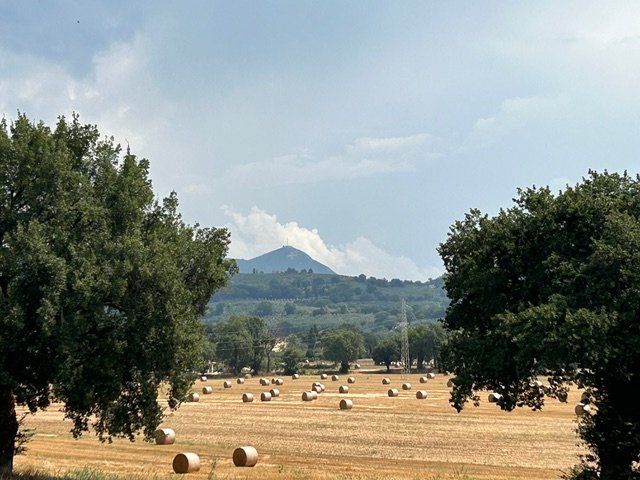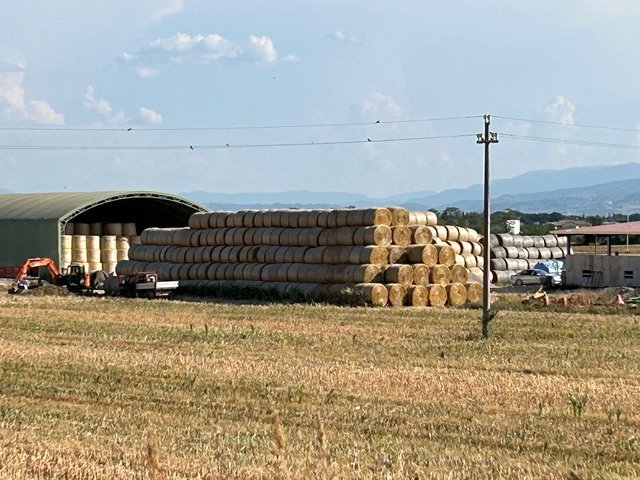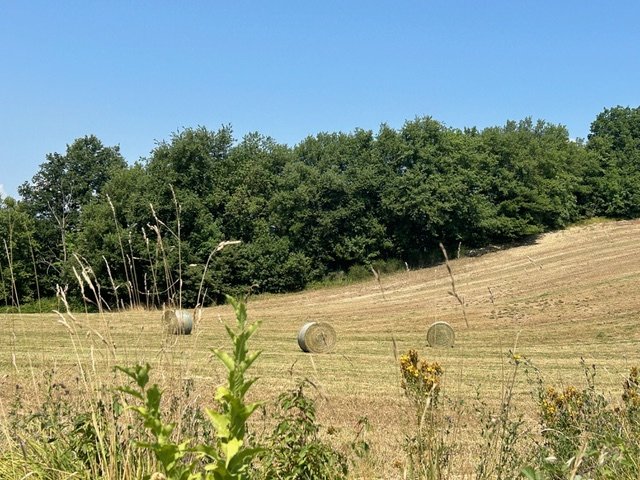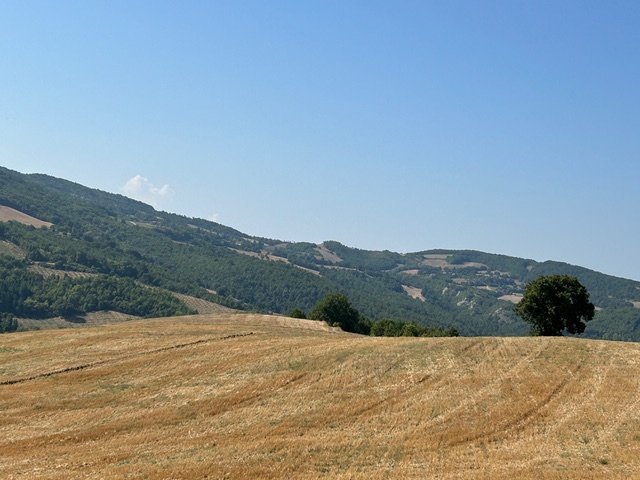WE REALLY NEED A PLAN
The parched fields in southern Sicily. Photograph: Roberto Salomone/The Guardian
It is September and throughout Italy the heat and dry conditions continue. It has been the hottest two months ever recorded. What little rain we have had has hardly penetrated the hard ground. There are food shortages already. The prices in the supermarkets are higher. In the south, the citrus crop is threatened; there is fungus on the lemons and the orange harvest is plagued by insects. Sicily and Sardenia are experiencing their worst drought in recent history and are among the six Italian provinces in an extreme water crisis. In the north, the Po River, which supplies the water for all our rice and supports 40% of Italy's agricultural output, suffered a major drought two years ago. Now, with very low flow, it is experiencing the slow and progressive infiltration of salt water from the Adriatic Sea, leaving the land worthless for farming. And the coastal waters of the Adriatic, where Italians love to vacation, are registering water temperatures of 30 degrees and above. As a result, the water along the beach is coated with a foam of microalgae making fishing difficult if not impossible. Four provinces have asked the government to declare a state of emergency. And, though I only read this in fairly alternative agricultural blogs, decreases in agricultural yields may be as high as 40%.
And Italy is faring far better than the 59 countries/territories facing 'high levels of acute food insecurity requiring urgent food and livelihood assistance'. Nambia, facing drought, plans to kill elephants for meat. That was the headline in the New York Times last week.
In the face of this crisis, we talk about community resilience and we tell ourselves that when the shit hits the fan, the local farms will feed us. That would be wonderful but in fact it is not possible. Not now.
And why is there so little about this in the news? Both The Guardian and La Repubblica bury any environmental news after the sports section. The New York Times gives less space to articles about devastating species loss, deforestation, and starvation than they do to recipes. (That was rhetorical. We all know why.)
It is one thing to read about food shortages, drought, famine in the newspapers. It is another thing to be on the ground in this heat, on the parched earth working in silence where just a few summers ago there was a cacophony of wild bird conversations. The local farmers here have no crops for the community. In Umbria, in my valley, we are all farmers on small family farms. Umbria is the bread basket of Italy and we primarily grow grains: wheat, hay, farro. The fields are not irrigated; the seeds are sown after the fall rains, in mid-October, and grow into late spring. They need to be cut dry, in mid-June, the beginning of our hot and dry summer. Then the land is left fallow until the rain returns. Hay, the major crop around here, is for our large animals. Though I also grow hay, I am an exception, the only farm in my valley registered to sell eggs. Our cash crops do not/cannot feed the community.
To be clear, the local farmers can feed themselves. Behind all of our homes, we have the orto, the family vegetable garden. It has kept us alive through Italy's wars and times of famine. It includes much more than seasonal vegetables. We all have fruit and nut trees, grapes, berry brambles, and the inevitable potato patch. Every family in the valley has olives and figs. Adjacent to the family garden are shelters for our chickens and ducks, though many also raise pigeons, geese, and guinea fowl. And rabbits. Some have a few donkeys and sheep which browse for food in the meadows and forests which comprise most of the land in our valley.
We grow enough to live very comfortably... in our private gardens. And therein lies the caveat: the orto is only for the family. It is not part of our business. We have just enough of all the food and nutrition essentials out back behind the house to see ourselves through each season. (And just enough stored rain and underground springs to keep those plants alive.) But there is not enough to share with the surrounding communities—and this year there is less. We cannot possibly feed the local population, even with farmland extending right up to the major cities in our province. Only in our private gardens do we begin to rival the produce section of the supermarket.
And the world cannot depend on industrial agriculture, nor would we want to. They were and are a large part of creating this mess. In the U.S., aquifers are shrinking nationwide, threatening supplies of drinking water and America’s ability to be a world grain provider. Industrial agriculture has a history of water pollution, waste and abuse. World-wide, 70% of our water is used by agriculture. Agribusiness is the single largest consumer of our water resources—660 trillion to 1 quadrillion gallons annually. Our ever increasing water extraction has depleted our watersheds and compromised our irrigation systems.
The small farms throughout the world cannot fill the gap; they currently provide only 28–31% of our food. With drought conditions those values are less. And the CSA's—many with scores of large plastic greenhouses and energy-intensive machines to wash and sort, cool or heat, and spray water automatically—are far from regenerative and resilient, verging close to industrial agriculture. (And factory-created food from bacteria? It could not be further from being simple, natural and self-sustaining.)
Collapse is here. It is all around us. Our ecosystems, our wildllife are in perilous decline. And our farmland. We need to know where our nutrition and clean water will come from in the future and how we will obtain it. I agree with Chris Smaje that the future for most people will be rural. If we are to survive, if our ecosystems and our wildlife are to survive at all, most of us need to become small scale farmers, backyard and rooftop market gardeners, homesteaders... And that is what 'sustainable' is all about—providing for our own needs while not diminishing the resources for others (including other creatures). There was a time when everyone knew how to grow their own food, to forage, to hunt. Children too. We grew food in cities during the world wars—victory gardens. What happened to being pro-active, to being self-reliant (within your family or immediate community). We often say that our best, most memorable times are sharing food with family and friends. That says it all. But we are so far from being capable of taking care of our most basic needs—acquiring food, water, shelter. We talk the talk about getting back to basics, living small, learning simple crafts, honoring indigenous wisdom, being part of the natural world...
Well, now it's time to fully embrace our intentions... while we still can..
© www.thesubversivefarmer.net September 2024
The photos were taken this month, all within 25 kilometers of my farm. There were no crops being harvested or planted anywhere along the road. Just yellow fields where the hay and wheat were cut.
Further reading:
https://www.sciencedirect.com/science/article/pii/S2211912417301293 on How much of the world's food do smallholders produce?
https://www.ncei.noaa.gov/news/us-drought-weekly-report-august-27-2024
In a previous lifetime, Zia Gallina worked as a botanist for the National Parks Service, on the C&O Canal outside of Washington D.C. (lecturing on wild indigenous and naturalized medicinal and culinary plants). She was also an adjunct professor teaching biology and environmental science at American University, Washington D.C. But she has always been a champion of small-scale biointensive farming, tagging behind Mother Nature, trying to stay as close as she can get.




